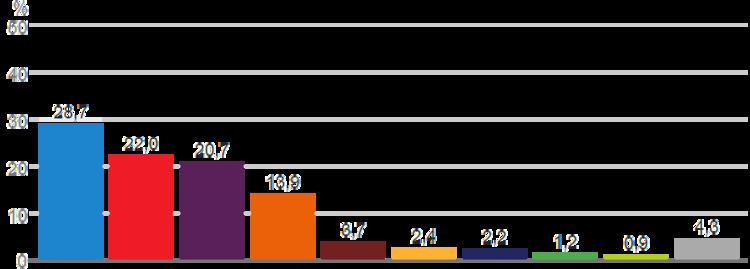This is the regional results breakdown of the Congress of Deputies election held in Spain on 20 December 2015, showing results in each of the country's 17 autonomous communities as well as in the autonomous cities of Ceuta and Melilla.
The Spanish electoral system was regulated under the Organic Law 5/1985, of 19 June, of the General Electoral System. A total of 350 seats were elected for the Congress of Deputies, with Ceuta and Melilla electing one member each using plurality voting. The other 348 seats were distributed among 50 multi-member constituency—each corresponding to a province—, with an initial minimum of two seats per constituency and the remaining 248 being awarded in proportion to the districts populations. For the election of deputies, the D'Hondt method and a closed list proportional representation was used, with a threshold of 3% of valid votes—which included blank ballots—being applied. Parties not reaching the threshold were not taken into consideration for seat distribution.
Voting was on the basis of universal suffrage, with all nationals over eighteen and in the full enjoyment of all political rights entitled to vote—however, amendments to the electoral law in 2011 required for Spaniards abroad to apply for voting before being permitted to vote, a system known as "requested" or expat vote (Spanish: Voto rogado)—. Gender quotas were introduced in 2007, requiring for party lists to be composed of at least 40% of candidates of either gender and for each group of five candidates to contain at least two males and two females. Groups of electors were required to obtain the signatures of at least 1% of registered electors in a particular district in order to be able to field candidates, whereas parties and coalitions left out from the Congress in previous elections were required to obtain the signatures of at least 0.1% of registered electors in the districts they intended to contest.
Alliances and coalitions
The People's Party ran in alliance with Navarrese People's Union (in Navarre), Aragonese Party (in Aragon) and Asturias Forum (in Asturias).
The Spanish Socialist Workers' Party ran in alliance with New Canaries (in the Canary Islands) and Independent Socialists of Extremadura (in Extremadura). Both the PSOE and the Socialists' Party of Catalonia called themselves sister parties, not competing against each other in the same geographical regions and forming one group within the Congress.
Podemos ran in alliance with Equo, Assembly for Madrid (in Madrid) and Now Upper Aragon in Common (in Huesca). It also included the three regional "confluences": En Comú Podem (alliance of Barcelona en Comú, Podem, Initiative for Catalonia Greens and United and Alternative Left and Equo), És el moment (Podemos and Coalició Compromís) and En Marea (Podemos, United Left, Anova-Nationalist Brotherhood and Encontro Cidadá por unha Marea Galega).
Popular Unity was the coalition of United Left, Building the Left–Socialist Alternative, Aragonese Union (in Aragon), Batzarre (in Navarre), Asturian Left (in Asturias), Castilian Left (in Castile and León) and Segoviemos (in Segovia).
Republican Left of Catalonia ran in alliance with the Catalonia Yes platform, while in the Valencian Community it ran within the Now, Valencian Country coalition together with The Greens–The Greens of the Valencian Country and Valencian Nationalist Left–URV.
Democracy and Freedom was the coalition of Democratic Convergence of Catalonia, Democrats of Catalonia and Reagrupament.
Euskal Herria Bildu was the coalition of Sortu, Eusko Alkartasuna, Alternatiba Eraikitzen, Aralar and independents from the abertzale left.
Canarian Coalition, Canarian Nationalist Party and Independent Herrenian Group ran in alliance.
Nós–Candidatura Galega was the coalition of the Galician Nationalist Bloc, Galician Coalition, Galician Workers Front, Communist Party of the Galician People and Democratic Galicianist Party.
Geroa Bai was the coalition of the Basque Nationalist Party, Zabaltzen and Atarrabia Taldea in Navarre.
Més was the joint candidacy of More for Majorca and More for Minorca.

